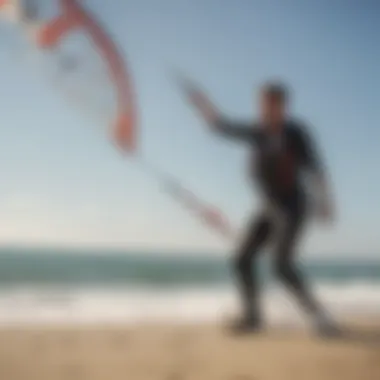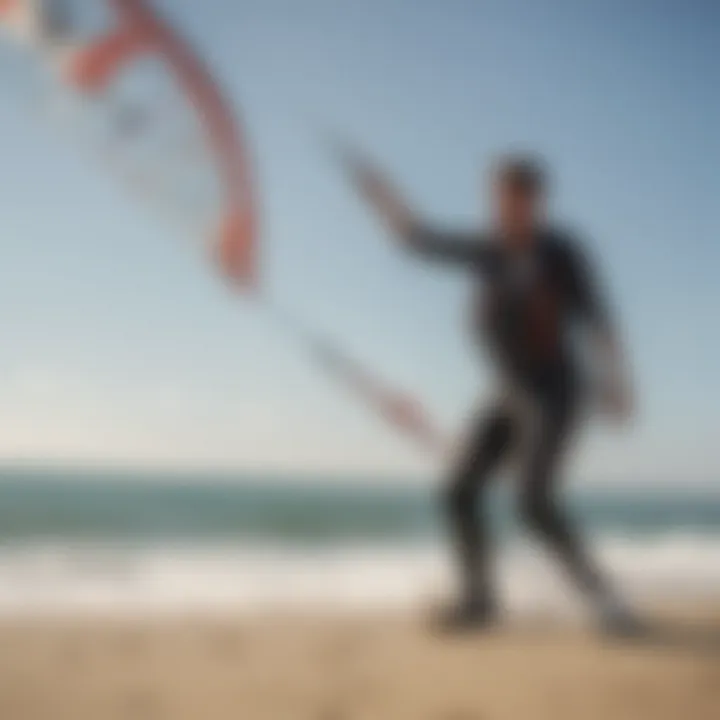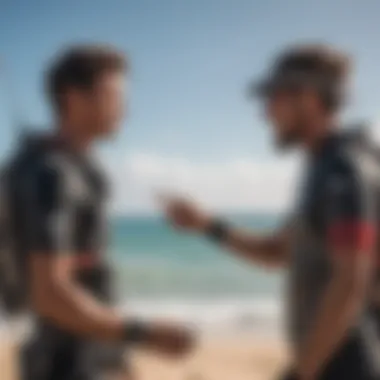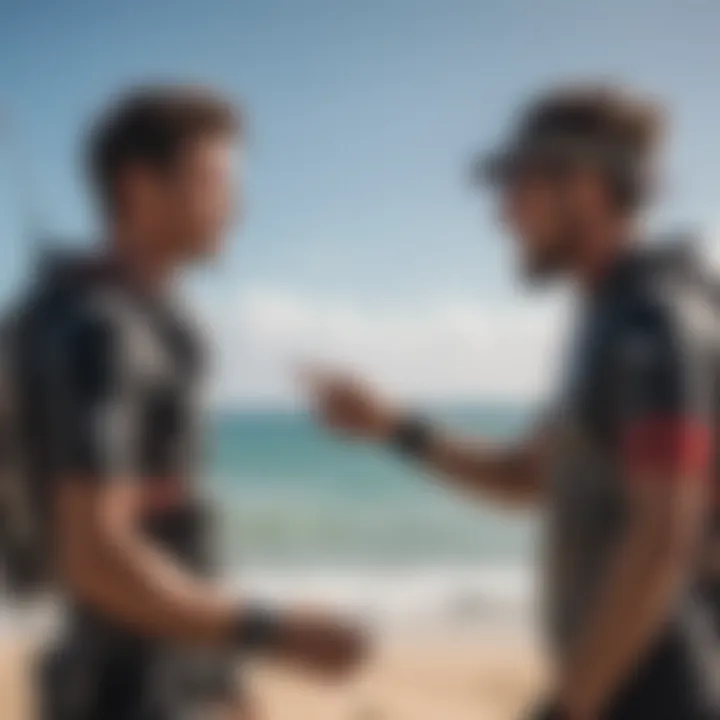The Essential Role of Kite Surfing Trainers


Intro
Kite surfing has surged in popularity, and with it, the demand for qualified trainers. These professionals play a pivotal role in fostering a safe and enjoyable learning environment for newcomers, as well as helping seasoned riders hone their skills. In this article, we will explore the intricate dynamics of kite surfing trainers, focusing on their qualifications, methodologies, and the influence of modern technology on their approaches.
Understanding the depth of a trainer's role is essential for both learners and aspiring instructors. The function of a kite surfing trainer encompasses more than just teaching skills; they are agents of safety, mentors, and sometimes even friends. As the sport evolves, so do the requirements for effective instruction. Trainers must adapt to the peculiarities of individual students while also embracing advancements in equipment and techniques.
Through insights into training practices and the kitesurfing ecosystem, readers will gain a more profound understanding of what makes an effective kite surfing trainer. Let's delve into the critical areas that define this profession, starting with the essential equipment they utilize in their training.
Prolusion to Kite Surfing Training
Effective kite surfing training is layered with evolution, reflecting advancements in techniques and devices. Students often gain from structured learning that enhances their confidence and performance on the water. Without professional trainers, learners may adopt unsafe habits, leading to accidents or discouragement. Thus, recognizing the importance of trained professionals in kite surfing cannot be overstated. Trainers are the backbone of the sport, shaping the next generation of kite surfers and ensuring a vibrant future for the kiting community.
The Evolution of Kite Surfing Lessons
Kite surfing lessons have come a long way since the sport's inception. Initially, instruction was haphazard, often reliant on personal experience or informal mentorship. As kite surfing gained traction in the late 1990s and early 2000s, organizations began to emerge, standardizing training methods and safety protocols. Over the years, this has led to structured curriculums designed to progress a student's skills logically and efficiently.
Today's kite surfing lessons incorporate a variety of teaching methodologies, including on-water practice, simulator training, and in-depth theoretical knowledge. These approaches aim to provide a holistic understanding of the sport. The scope of lessons has broadened, addressing not only the mechanics of kite handling but also environmental awareness, equipment maintenance, and injury prevention strategies. This evolution reflects a growing recognition of kite surfing as a serious sport that deserves professional instruction.
Importance of Professional Training
Professional training in kite surfing holds several key benefits. First and foremost, it enhances safety. Trainers are equipped to teach students how to assess conditions, use their gear correctly, and react appropriately in emergencies. A professional kite surfing trainer helps to mitigate risks that come with outdoor sports, particularly those as dynamic as kite surfing.
Moreover, professional training optimizes skill development. Experienced trainers can identify individual student needs and tailor their instruction accordingly. They have the knowledge to instill fundamental techniques that facilitate smoother progression. This can lead to faster learning curves and higher enjoyment levels. Furthermore, a structured learning path leads to better retention of skills and concepts, advantageously positioning students for advanced experiences.
"Safety and skill development are intertwined in kite surfing training; one cannot exist effectively without the other."
In the following sections, we will delve deeper into what defines a kite surfing trainer's responsibilities and abilities.
Defining the Role of a Kite Surfing Trainer
Defining the role of a kite surfing trainer is essential in understanding how effective learning experiences are crafted in the sport. Trainers serve as the bridge between novices and the keen mastery of kite surfing skills. Their responsibilities encompass not only technical guidance but also emotional and psychological support. Trainers are tasked with ensuring that each lesson aligns with the student’s individual capacity and understanding. This personalized approach is pivotal for students to develop confidence and competence on the water.
The importance of this role cannot be overstated. Kite surfing is an activity that can be dangerous without proper instruction. By establishing safety protocols and fostering an environment of trust, trainers create a learning atmosphere where students can thrive. Moreover, they are instrumental in teaching the nuances of wind and water dynamics, which are central to successful kite surfing.
Core Responsibilities
A kite surfing trainer undertakes several core responsibilities that define their role:
- Instruction: Provide clear guidance on kite set-up, flying techniques, and water handling. This is fundamental for preparing students.
- Safety Management: Prioritize the safety of students by teaching risk assessment and implementing emergency protocols. This ensures that students learn responsibly.
- Progress Tracking: Monitor student capabilities regularly to adapt lessons for optimal learning. Keeping records helps in setting achievable targets.
- Equipment Knowledge: Instruct students on the selection and care of personal kite surfing gear, ensuring they recognize the importance of using appropriate tools.
- Environmental Awareness: Train students on understanding local weather and water conditions, which can significantly impact their learning and safety.
Effective trainers balance these responsibilities to foster a comprehensive and enjoyable learning environment.
Difference Between Trainer and Instructor
While the terms trainer and instructor are often used interchangeably, there are notable differences.
- Focus on Training: A trainer emphasizes the development of skills over time, focusing on both physical and mental aspects of kite surfing. They work on building long-term competencies.
- Diverse Skill Development: Trainers are involved in holistic skill enhancement. This includes not just technical skills but also fostering confidence and decision-making abilities.
- Personalized Learning Plans: Trainers typically create tailored lesson plans that cater to the unique needs of each student. In contrast, instructors might rely on standardized methods.
Qualifications and Skills Required
The realm of kite surfing is as thrilling as it is nuanced. Having the right qualifications and skills as a trainer is fundamental. This is not just about having fun on the water; it is about ensuring safety and effective learning. A kite surfing trainer must be well-rounded in several areas to guide students safely and efficiently.
Certifications and Credentials
Certifications play a pivotal role in establishing a trainer's credibility. They signal to potential students that the trainer has undergone formal training and assessments, ensuring they possess relevant knowledge. Many organizations, such as the International Kiteboarding Organization (IKO) and the Professional Air Sports Association (PASA), provide certification programs. These credentials can include instructor ratings, safety training, and first aid certifications.
The presence of recognized qualifications boosts a trainer's marketability. A certified trainer is more likely to attract students. Assurance of safety through valid certifications helps students build confidence in their trainer's abilities. In an environment where the elements can change rapidly, having a trainer who adheres to professional standards is essential for risk management.
Essential Skills for Effective Training
Having qualifications is just one side of the coin. Trainers must also cultivate specific skills that enable them to teach effectively. Three key skills stand out in this regard: communication, safety awareness, and technical knowledge.
Communication
Communication forms the bedrock of effective instruction. A trainer must convey concepts clearly. The challenge lies not just in making information accessible, but in ensuring students grasp it fully.
Key characteristics include clarity and adaptability. A trainer with clear communication can break down complex maneuvers into digestible parts. This reduces student frustration and aids learning. Furthermore, adaptabiility ensures that a trainer can adjust their teaching style based on each student's unique learning preferences.
Unique features of effective communication include active listening and feedback. These aspects create an environment where questioning is encouraged, enriching the learning experience. While communication is generally beneficial, not all trainers are equally skilled. A trainer with poor communication may hinder progress or cause confusion.
Safety Awareness
Safety awareness cannot be overstated in kite surfing. A trainer well-versed in safety protocols is a layer of protection for students. Understanding potential risks allows trainers to mitigate them effectively.
The key characteristic of safety awareness is vigilance. A trainer must continuously assess environmental conditions and student capabilities. Having a thorough understanding allows trainers to make informed decisions and adapt lessons to prevent accidents.
Unique features in this category include emergency preparedness and swift judgment. While safety training is vital, one aspect that can be disadvantageous is over-caution, which may hinder skill development. Balancing safe practices with encouraging students to push their limits is crucial.
Technical Knowledge


In kitesurfing, technical knowledge covers various areas, from equipment handling to understanding weather patterns. A trainer must be proficient in the various intricacies of the sport to provide a comprehensive education.
The essential characteristic is expertise. A trainer’s technical knowledge allows them to troubleshoot issues and advise students on equipment selection and care. This depth of knowledge facilitates a richer training experience.
Unique features include understanding aerodynamics and kite dynamics. However, the downside is that some trainers may become so absorbed in technical details that they forget to teach practical applications, which can limit a student's proficiency.
In summary, the combination of certifications, communication skills, safety awareness, and technical knowledge equips kite surfing trainers with the tools necessary for effective instruction. Each aspect contributes to creating a positive and secure learning environment for students.
Teaching Methodologies
Teaching methodologies are crucial in kite surfing training because they shape the learning experience for students. The right methods can significantly enhance skill acquisition and safety practices. Effective training often focuses on personalized approaches, adapting to each student’s pace and skill level. This flexibility is important. It allows trainers to create a dynamic learning environment that can accommodate diverse learning styles. Therefore, understanding various teaching methodologies is a fundamental aspect of a kite surfing trainer's role.
Progressive Learning Techniques
Progressive learning techniques provide a structured way to introduce skills gradually. This approach breaks down complex maneuvers into simpler components, facilitating easier understanding. For instance, a beginner may start with basic board control before progressing to more advanced techniques like jumping or tricks. This method builds confidence and ensures that students don't feel overwhelmed. Moreover, the emphasis on gradual skill development helps in reinforcing foundational techniques. As students master essential skills, they gain the ability to tackle more challenging aspects of kite surfing.
Utilizing Tools and Technology
In today’s training environment, utilizing tools and technology has become more prevalent and necessary. These tools enhance both teaching methods and the overall learning experience. They allow trainers to provide immediate feedback and extensive insights into a student’s performance. The two most notable tools in this category include video analysis and telemetry equipment.
Video Analysis
Video analysis is an effective method in kite surfing training. It allows both trainers and students to review performances critically. By recording sessions, trainers can point out specific areas where students excel or need improvement. This reflective practice is beneficial because it promotes self-awareness. A key characteristic of video analysis is that it helps in visualizing techniques in a way that verbal instructions may not convey. Therefore, this method is particularly popular among trainers. One unique feature is the ability to slow down footage, making it easier to analyze movements. The main advantage is that it provides detailed feedback, allowing students to make informed adjustments. However, a potential disadvantage may be the reliance on technology, which can distract from on-the-water experience.
Telemetry Equipment
Telemetry equipment offers another layer of insight into performance. This technology collects data on speed, jump height, and even kite angle during training sessions. A vital aspect of telemetry is its capacity to provide quantitative measurements, which can substantiate qualitative assessments made by trainers. It is a beneficial tool because it delivers real-time data, which is essential for understanding a student’s performance. The uniqueness of telemetry equipment lies in its ability to create a detailed performance profile, assisting trainers in tailoring future lessons. Although it can be expensive, its advantages, such as enhancing performance analysis and promoting goal setting, outweigh the costs for many trainers and students.
The integration of modern technology into kite surfing training can elevate both coaching effectiveness and student progress.
The Trainer-Student Relationship
The relationship between a kite surfing trainer and their student is pivotal for effective learning and skill development. This interaction acts as the foundation for a productive training environment, enabling students to safely and efficiently master the necessary techniques of kite surfing. A strong trainer-student relationship is characterized by trust, communication, and mutual respect, all of which contribute significantly to the overall learning experience.
Building Trust and Rapport
Trust forms the core of any successful trainer-student relationship. When students feel confident in their trainer’s abilities and intentions, they are more likely to engage wholeheartedly in the learning process. Building trust requires trainers to demonstrate competence in both their teaching methods and technical skills. An effective trainer should be approachable, creating a safe space for students to ask questions and seek guidance. This can involve sharing personal experiences or acknowledging their own learning curves, allowing students to see the trainer as relatable rather than just an authority figure.
Rapport can be fostered through positive reinforcement. Acknowledging the small achievements of students instills confidence and motivation. Additionally, trainers can engage in casual conversations, making the environment feel less intimidating. This builds a sense of community that encourages students to perform at their best and continually strive for improvement.
Feedback and Adaptation
Feedback is crucial in any teaching process, particularly in a sport that involves complex techniques like kite surfing. It allows students to understand their progress and areas that need improvement. Trainers should provide constructive feedback, focusing on how students can improve rather than solely pointing out mistakes. This approach encourages students to view feedback as a learning tool rather than criticism.
Adaptation comes into play when considering that each student has a unique learning style and pace. Trainers should assess their teaching methods regularly and be willing to adjust their approach based on the student’s responses. For example, if a student struggles with a particular maneuver, it may be beneficial to modify the lesson plan to emphasize relevant techniques or training drills. This personalized attention not only accelerates skill acquisition but also strengthens the relationship, as students feel their individual needs are recognized and prioritized.
"A successful trainer-student relationship is built on trust and is critical for enhancing the learning process in kite surfing."
Safety Protocols in Training
Safety protocols are a cornerstone of kite surfing training. They are essential for ensuring the well-being of both trainers and students. With the unpredictable nature of wind and water conditions, having clear safety protocols can prevent accidents and foster a secure learning environment. This section explores the specific elements of risk awareness and emergency procedures that trainers must uphold.
Risk Awareness and Management
When it comes to kite surfing, risk awareness is not just a recommendation; it is a fundamental necessity. Trainers need to assess environmental conditions regularly. This includes monitoring wind speeds, tide levels, and local traffic in the water. They should provide students with tools to recognize potential hazards, such as strong currents or nearby obstacles, thereby empowering them to make informed decisions.
Additionally, trainers must emphasize the importance of personal responsibility in managing individual risks. For example, students should be educated on understanding their limits while kite surfing. This means recognizing when conditions are unsuitable for their skill level.
Effective risk management involves proactive steps, such as:
- Pre-training assessments to evaluate both the student's physical health and skill level.
- Constant communication regarding changing conditions during a training session.
- Use of proper safety equipment, such as life jackets and helmets, which is important to minimize the risks associated with the sport.
By integrating these practices, trainers can reinforce the significance of safety in kite surfing, contributing to a culture of awareness and risk management.
Emergency Procedures
Just as essential as risk awareness is the establishment of emergency procedures. These procedures should be thoroughly integrated into training sessions to ensure that both trainers and students know the steps to take in case of an incident.
Emergency procedures might include:
- Rescue protocols for dealing with a downed kite or an injured student. Trainers must demonstrate how to safely retrieve a fallen kite and assist the student in the water.
- Communication plans which outline how to signal for help, whether that involves using a whistle or waving a hand.
- First aid training for trainers so that they can respond effectively in emergencies, addressing injuries or distress without delay.
"In kite surfing, having a clear set of emergency procedures can be the difference between a minor incident and a serious accident."
The aim of these emergency procedures is to build confidence among students. When learners are assured of their safety, they are more likely to focus on improving their skills. Overall, the implementation of these protocols not only enhances individual performance but also contributes to the broader kite surfing community’s safety culture.
Integrating Environment and Conditions
Understanding the role of kite surfing trainers includes acknowledging how environmental factors significantly impact training. Integrating understanding of the conditions ensures effective learning. Weather factors such as wind strength, direction, and wave patterns play a crucial role in determining the safety and effectiveness of kitesurfing sessions. Additionally, recognizing the environmental context helps trainers tailor their methodologies to match the dynamic conditions learners will face.
Adapting Training to Weather Factors


A kite surfing trainer must be adept at adapting to changing weather situations. For example, a sudden increase in wind speed may require the trainer to switch from beginner lessons to more advanced techniques. This adaptability is not just beneficial, but necessary.
Factors to consider during training include:
- Current wind conditions: Knowing safe wind ranges helps trainers impart essential safety lessons to students.
- Temperature and sun exposure: Adjusting lesson length based on thermal comfort can improve student focus.
- Tidal changes: Understanding how tides influence wave conditions can be critical for training locations.
Locational Training Insights
Coastal Areas
Coastal areas are often the premier locations for kite surfing training. The expansive open water allows for longer practice sessions without interruptions, which helps students gain confidence quickly. Winds blowing off the ocean tend to be consistent, favoring skill development.
Key aspects include:
- Accessibility to various skill levels: The shallow areas near the coastline make it safer for beginners,
- Environmental considerations: These locations offer clear visibility and can be monitored easily.
However, coastal training can also present challenges. Waves and tides can be unpredictable and might necessitate extra attention from trainers. The interaction with marine life, like jellyfish, can affect training sessions.
Large Lakes
Large lakes provide another excellent training environment for kite surfing. They often have less turbulent conditions compared to oceanic settings, making them suitable for beginner lessons. Plenty of open space allows trainees to practice maneuvers without fear of interruption.
Unique features of large lakes:
- Controlled environment: With fewer elements at play, trainers can maintain session focus, hence maximizing learning.
- Wind consistency: While wind conditions can vary, certain lakes often have predictable patterns, which trainers can leverage.
On the downside, large lakes may not present the same thrill as ocean surfing. The experience may feel limited if the goal is to practice maneuvers that require waves. Nonetheless, for functional training, they serve as effective environments.
Adapting to environmental conditions is key for both safety and progress in kite surfing training. Every location brings unique opportunities and challenges that trainers must navigate.
Assessing Student Progress
Assessing student progress in kite surfing training is essential for trainers and students alike. It provides a clear framework to measure development and determines the effectiveness of the training methods employed. This process goes beyond simple acknowledgment of skill acquisition; it encompasses setting achievable objectives, tailoring training programs, and ensuring safety in practice. Without proper assessment, students may feel lost, stagnant or even unsafe in their learning journey. Thus, regular assessment maintains motivation by highlighting improvements and identifying areas needing attention.
Setting Milestones and Goals
Establishing milestones and goals plays a critical role in the progression of a kite surfer. The first step in this process is to break down the broader, often overwhelming objectives into more manageable tasks. For instance, a student aiming to perform a jump may first focus on mastering the basics of steering and balance.
- Specific Goals: Define precise and attainable targets. This could be learning a specific maneuver or improving handling skills within a set timeframe.
- Measurable Milestones: Develop metrics to evaluate performance, such as the number of successful attempts or improvements in technique. This allows both trainers and students to visualize progress.
- Achievable Challenges: Goals should push students beyond their comfort zone, yet still be attainable. This builds confidence.
Regularly reviewing these milestones ensures that both the trainer and student are aligned in their expectations. This leads to a more dynamic training environment, fostering growth.
Evaluating Skills and Techniques
Evaluating the skills and techniques of students is vital for optimizing their learning experience. It allows trainers to give personalized feedback tailored to individual needs, emphasizing both strengths and weaknesses.
Trainers often utilize various tools to assess progress:
- Video Analysis: Recording sessions can visually highlight areas that require improvement. This allows athletes to see their techniques from a different perspective, which is often enlightening.
- Direct Observations: On-the-spot evaluations during practice can provide immediate feedback, ensuring students adapt their techniques in real-time.
- Peer Review: Encouraging students to discuss each other’s performance fosters a collaborative learning environment. They can share insights and tips that might benefit their peers.
"The only way to improve is to be open to constructive criticism, and assessing skills provides the framework for that growth."
In summary, assessing student progress in kite surfing training serves multiple crucial functions. It enables trainers to adapt their approaches, ensuring that students develop at a pace that suits their individual learning styles. Furthermore, clear milestones and thorough evaluation practices contribute to a safer, more effective learning environment.
The Impact of Technology on Kitesurfing Training
The role of technology in kite surfing training cannot be understated. As the sport evolves, the integration of technology not only enhances training efficiency but also improves the overall learning experience for both trainers and students. Understanding how technology influences training methods is crucial for trainers looking to offer competitive and effective instruction.
Emerging Trainer Tools
Various innovative tools have emerged to assist kite surfing trainers in their teaching practices. These tools range from safety equipment to performance analysis devices.
- Wearable Technology: Devices like smart watches or fitness trackers monitor heart rate and physical exertion during lessons. This information helps trainers tailor their teaching to the student’s physical stamina.
- GPS and Wind Sensors: These tools provide real-time data on wind speed and direction, helping trainers advise students on optimal conditions. Knowing when it is safe to take lessons or when to call it a day is invaluable.
- Drones: Utilized for aerial video analysis, drones give trainers and students the ability to review techniques and form from different perspectives. Analyzing video footage can reveal areas needing improvement that may be missed during lessons.
- Simulation Software: Some trainers use virtual reality systems or computer software to simulate kite surfing conditions. This method allows students to practice skills in a controlled environment before hitting the water, reducing anxiety.
These tools not only improve teaching methods but also enhance safety and monitoring of student progress.
Online Training Platforms
With the rise of online learning, kite surfing training has expanded beyond traditional face-to-face lessons. Online platforms now offer resources and learning tools that complement physical training.
- Video Tutorials: Many platforms host extensive libraries of instructional videos, which students can access anytime. These videos cover a range of skills from basic setup to advanced maneuvers.
- Community Forums: Platforms like Reddit and Facebook provide spaces where students and trainers can share experiences, ask questions, and give advice. This shared knowledge fosters community and adds value to learning.
- Interactive Webinars: Trainers can conduct live webinars, allowing students to interact in real-time, ask questions, and receive immediate feedback. This real-time aspect can help students build a deeper understanding of techniques.
- Progress Tracking Applications: Some apps help students set goals and track their progression over time. These applications can create a sense of accountability and motivation.
"Technology enables trainers to reach more students and provide a higher quality of instruction than ever before."
By combining traditional teaching methods with modern technology, trainers can offer a more comprehensive learning experience. Students not only gain practical skills but also enjoy a more engaging and informative approach to kite surfing.
Challenges in Kite Surfing Training
Kite surfing training presents numerous challenges, which can greatly affect the effectiveness of both the trainer and the student. Understanding these challenges is essential for anyone involved in the field, as it not only enhances training quality but also contributes to the overall safety and enjoyment of the sport. This section explores two main categories: physical and mental barriers, as well as resource limitations, both of which can hinder the training process.
Physical and Mental Barriers


Physical barriers in kite surfing often relate to personal fitness levels. Many students may not have the required physical conditioning to handle the demands of the sport. Strength, endurance, and flexibility are crucial for kite surfing. A lack of these can lead to frustration and slower progression. Additionally, those with pre-existing injuries may struggle to adapt to the physical requirements, which can reduce motivation and confidence.
Mental barriers hold equal significance. Kite surfing requires a specific mindset. Many beginners face anxiety or fear of the water, which can inhibit their progression. This anxiety might originate from a previous bad experience related to water sports or simply from the unfamiliarity of kite surfing. Trainers must find ways to help students with these mental barriers. Mental conditioning can often be as important as the physical training that the students undergo.
To address these barriers, trainers should implement tailored physical conditioning programs before commencing training sessions. Recognizing the mental aspects means being patient and encouraging while also helping students build their confidence gradually.
Resource Limitations
Resource limitations can manifest in several ways and pose significant challenges in kite surfing training. These limitations could include lack of access to proper equipment, training facilities, or safe locations conducive to learning. Kite surfing requires specific gear such as kites, boards, and safety equipment. For new students, this equipment can be costly. Some may not have access to rental equipment or may find it challenging to afford the right gear to enhance their learning experience.
Furthermore, in some areas, geographical constraints can limit training opportunities. Students in regions without accompanying water bodies or windy conditions may have difficulty finding a suitable training venue. Trainers need to be resourceful and adaptive to find alternate solutions for their students.
In summary, the challenges of kite surfing training are multifaceted, requiring trainers to adopt a holistic approach. They must address physical and mental barriers while also being creative in overcoming resource limitations. By recognizing and tackling these challenges, trainers can provide a more robust and effective learning environment for their students.
"An effective trainer is one who sees not just the skills to be learned but also the barriers to be overcome."
Understanding these challenges makes for better training practices and ultimately fosters a more satisfying and safer experience in the thrilling world of kite surfing.
Community and Networking for Trainers
In the realm of kite surfing, the significance of community and networking cannot be understated. It serves as the backbone of the kitesurfing fraternity, fostering relationships among trainers, students, and enthusiasts alike. A trainer's ability to connect with others in the industry is paramount, as it leads to shared experiences, knowledge, and resources. This interconnectedness also enhances the overall quality of training.
Trainers who engage with a wider community gain access to diverse teaching methodologies and innovative techniques. As they share insights and experiences, they also develop personal growth and adaptability in their training methods. Furthermore, being part of a community encourages collaboration and support, crucial elements in a sport that thrives on safety and progress. The benefits extend beyond individual trainers, influencing the broader kitesurfing ecosystem.
Networking also opens doors to opportunities, such as partnerships with local shops, sponsorships from brands, and participation in various events. These connections can significantly impact a trainer’s career trajectory and marketability. The continuous evolution of kite surfing means trainers must remain informed and relevant.
Building a Trainer Community
Creating a strong community among kite surfing trainers is vital for professional development. This can be achieved through various means. Here are some effective approaches:
- Social Media Engagement: Platforms like Facebook and Reddit offer a space for trainers to connect, share advice, and discuss best practices. They can also promote events and workshops.
- Local Meetups: Organizing gatherings allows trainers to develop relationships face-to-face, share experiences, and discuss challenges specific to their region or demographic. These connections can empower trainers to innovate collectively.
- Online Forums: Websites and forums dedicated to kite surfing serve as repositories of knowledge. Here, trainers can seek advice and explore training techniques.
Building a robust trainer community is not just about making connections; it's about enhancing the training experience for students by creating a supportive framework.
Engagement in Kitesurfing Events
Participating in kite surfing events is another avenue through which trainers can strengthen their networks. These events provide opportunities to meet fellow trainers, exchange ideas, and gain exposure. Key aspects include:
- Competitions: Trainers can learn from observing different styles and techniques in competition settings and apply these insights to their training.
- Workshops: Attending or conducting workshops at events allows trainers to share methodologies and receive feedback. Collaborative learning can result in improved training programs.
- Networking Opportunities: Events serve as platforms for trainers to meet potential sponsors or collaborators, which can have far-reaching implications for their careers.
The Future of Kite Surfing Training
The future of kite surfing training is a critical area of exploration as it holds the potential to shape the next generation of kitesurfers. With the sport gaining popularity globally, understanding emerging trends and predictions can provide insights for both trainers and learners alike. The evolution of training methodologies, influenced by technology and environmental factors, will fundamentally impact how skills are developed and imparted in this dynamic sport.
Trends Influencing Training Practices
Several trends are currently influencing training practices in kite surfing. One significant factor is the integration of technology into the training environment. Tools like wearable devices and drone technology offer trainers new ways to monitor student performance and provide real-time feedback. For instance, using a drone to capture aerial footage can help students visualize their techniques and make improvements accordingly.
Another trend is the growing focus on safety and risk management. As kite surfing becomes more mainstream, trainers are increasingly prioritizing safety protocols. This shift not only protects students but also enhances the overall reputation of the sport. Training programs might incorporate more rigorous safety drills and emphasize environmental assessments to ensure safe practice conditions.
Key trends include:
- Increased use of technology for training and feedback.
- Greater emphasis on safety and risk management.
- Customization of training plans to suit individual student needs.
These trends exemplify how kite surfing training is adapting to meet modern demands and ensure a safe, productive training environment for all.
Predictions for the Industry
Looking ahead, several predictions can be made regarding the kite surfing training industry. One possibility is that the demand for certified trainers will increase. With kitesurfing clubs and schools expanding, more individuals will seek professional guidance to ensure they acquire the necessary skills in a structured manner. Therefore, trainers may need to pursue advanced certifications and training to remain competitive.
Moreover, online training platforms are likely to grow in significance. Virtual learning options can provide students with accessible materials and tutorials that complement their practical experiences. This blended approach can enhance learning, particularly in remote areas where access to trainers may be limited.
"As kite surfing continues to evolve, staying ahead of trends and predictions is crucial for trainers to effectively prepare their students."
In summary, the future of kite surfing training is marked by technological advancements, increased safety measures, and a shift towards online learning solutions. These factors collectively create a more efficient and effective training process, ensuring that both aspiring kitesurfers and seasoned athletes can benefit from a well-rounded educational experience.
Finale
The conclusion of this article serves as a crucial element in summarizing the overall significance of kite surfing trainers in the kitesurfing community. Kite surfing is not merely a sport; it embodies a complex interplay of skill development, safety, and personal growth. Trainers play an indispensable role, shaping not only the technical abilities of students but also their confidence and passion for the sport.
Key points discussed in the article highlight the requirements for trainers, the methodologies they implement, and the numerous challenges they face. Recognizing these aspects underscores how essential trainers are to the foundational experience for beginners and seasoned kite surfers alike.
Coming to a better understanding of a trainer's role allows students to appreciate the training process more deeply. This cooperation between students and trainers promotes a healthy learning environment. Additionally, as kite surfing evolves, so should the trainers. Adapting to advancements in technology and changing conditions in nature enhances the effectiveness of training.
In essence, the dynamic between the trainer and student reflects on the broader kite surfing community. As kite surfing continues to grow, trainers will remain a cornerstone of the kitesurfing experience, guiding newcomers while also refining the skills of established surfers.
Recap of Key Points
- Role of Trainers: Trainers are responsible for teaching techniques and promoting safety.
- Qualifications Needed: Proper certifications and skills are essential for effective training.
- Teaching Methodologies: A mixture of traditional and innovative tactics can enhance learning.
- Safety Protocols: Understanding safety is pivotal to a successful training experience.
- Technological Advances: Technology plays an increasingly significant role in improving training outcomes.
- Community Building: Engagement in the kitesurfing community is vital for trainers’ ongoing development.
Encouragement for Future Trainers
For individuals considering a career as a kite surfing trainer, it is essential to embrace continuous learning and skill enhancement. Each training session presents an opportunity to grow—both for the trainer and the student. Engaging with kitesurfing communities, both online and offline, can provide valuable insights and support.
Future trainers should focus on developing strong communication skills and building trust with their students. Understanding the special needs of each learner can drastically enhance the training experience. Don't shy away from seeking mentorship or networking with established trainers. This journey towards becoming proficient in kite surfing training is filled with challenges, but it will be rewarding.
Ultimately, the world of kite surfing is vast and evolves rapidly. Trainers who stay informed and adaptable will not only thrive in their profession but also inspire the next generation of kitesurfers.







